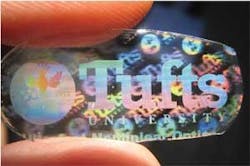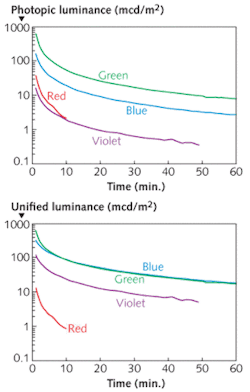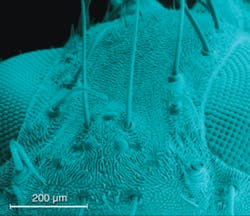Last year’s announcement that SPIE’s Photonics West 2010 will be held at the Moscone Convention Center in San Francisco, CA, is testament to the tremendous growth of what many people say is now the “must-attend” event of the optics and photonics industry. In 2009 Photonics West remains in San Jose, CA, and expects to host more than 17,500 attendees from Jan. 24 to 29.
The technical program is planned to be 10% larger than in 2008, with more than 3300 papers across four technical symposia: Biomedical Optics and Imaging (BiOS); Laser Devices and Materials (LASE); Optoelectronic Technologies and Applications (OPTO); and Micro- and Nanofabricated Electromechanical and Optical Components (MOEMS-MEMS). A sold-out exhibition from Jan. 27 to 29 will showcase the technologies of 1100 companies and institutions.
And to get an assessment of how photonics is faring in this tumultuous economy, be sure to attend the annual Lasers & Photonics Marketplace Seminar 2009 on Monday, Jan. 26, at the Fairmont Hotel in San Jose (for more information, see www.marketplaceseminar.com).
BiOS continues growth spurt
The BiOS symposium has become the largest of the four and, with 1500 papers, is up almost 15% compared to last year. Symposium chairs for 2009 are James Fujimoto of the Massachusetts Institute of Technology and R. Rox Anderson, M.D., of the Wellman Center for Photomedicine at Massachusetts General Hospital and Harvard School of Medicine. The BiOS program will feature 36 conferences organized into five program tracks: Photonic Therapeutics and Diagnostics; Clinical Technologies and Systems; Tissue Optics, Laser-Tissue Interaction, and Tissue Engineering; Biomedical Spectroscopy, Microscopy, and Imaging; and Nano/Biophotonics.
The symposium covers a wide range of current and emerging biomedical technologies, including optical coherence tomography (OCT) and multiphoton microscopy. Some conferences feature numerous invited talks. In the Frontiers in Pathogen Detection: From Nanosensors to Systems program (part of the Photonic Therapeutics and Diagnostics track), for example, there are 14 invited papers. The sessions cover systems that use various approaches to detect multiple pathogen types, surface-plasmon resonance (SPR) and surface-enhanced Raman scattering (SERS), waveguides, fluidics, and more.
Two short courses are offered on Monday, Jan. 26. Austin Roorda of the University of California-Berkeley teaches an introductory session called “Optics and Optical Quality of the Human Eye,” and Donald T. Miller of Indiana University presents an intermediate course called “Ophthalmic Adaptive Optics.”
A highlight of the symposium is the Saturday evening BiOS Hot Topics session that will again be moderated by Sergio Fantini of Tufts University. On the evening’s agenda is a series of 14-minute talks, starting with Stefan W. Hell of the Max-Planck-Institut für Biophysikalische Chemie (Germany) on “Nanoscopy with Far-Field Optics.” Wrapping up the evening, Fiorenzo G. Omenetto discusses the work of his team at Tufts University, which has created biocompatible optical elements, based on silk, that may form the bases of new sensors and greatly expand the use of optical technologies in areas like human and livestock health, environmental monitoring, and food quality (see Fig. 1).
On the BiOS show floor–a separate exhibition held January 24 to 25–more than 150 exhibitors will showcase their capabilities with specific application to biomedical optics. Numerous companies have already announced the launch of new products at the event.
OPTO goes quantum
The OPTO plenary session on Jan. 27 begins with Klaus Ploog, retired director of the Paul Drude Institute for Solid State Electronics (Berlin, Germany), discussing the “Challenges and Prospects of Conventional and Dilute III-Nitrides for Light Emitting Devices, Solid State Lighting, and Silicon Photonics.” Ray Beausoleil, distinguished scientist in the Information and Quantum Systems Laboratory of HP Labs (Palo Alto, CA), follows with “Photonics for Novel High-Performance Computing.” Also speaking at the plenary will be Paras N. Prasad, distinguished professor of chemistry, physics, medicine, and electrical engineering at the University at Buffalo, NY, who will present research on “Photonics’ Pivotal Role in the Nano/Bio/Info Revolution: New Interfaces to Meet the Challenges of the 21st Century.”
The OPTO portion of Photonics West 2009 features seven program tracks, each containing up to seven conference tracks brimming with papers over the course of the week, so conference attendees may have a hard time choosing which to concentrate on. Several invited papers may jump out as a starting point. In one, Jianlin Liu and colleagues at the University of California, Riverside, will discuss ultraviolet zinc oxide LEDs and quantum-well laser diodes. And in another invited paper on Wednesday, Peter Blood of Cardiff University (Cardiff, Wales) will discuss “A High-Temperature Single-Photon Source from Nanowire Quantum Dots,” combining two hot topics at the conference–single-photon sources and quantum everything.
No matter where you turn, the topic of the very small–quantum–will be big. An entire OPTO program track, “Advanced Quantum and Optoelectronic Applications,” is devoted to the topic, and besides that, program tracks within topic areas from materials to lasers and telecom have scheduled entire conference tracks on quantum topics. Nelson Tansu and colleagues at Lehigh University start the ball rolling on Monday with “Analysis of Current Injection Efficiency and Efficiency-Droop in InGaN Quantum-Well Light-Emitting Diodes.” The quantum world is repeated again and again in the conference program, with terms like “quantum-dash” joining the ubiquitous “quantum dot.” Michael Pochet and colleagues at the University of New Mexico (Albuquerque, NM) will give a couple of papers on quantum topics, including an analysis of the modulation response of an injection-locked quantum-dash Fabry Perot laser at 1.55 µm.
MOEMS-MEMS highlights fabrication and reliability
Micro- and nanofabricated electromechanical and optical components are on their way to becoming the essential technology behind computers, sensors, medical instruments, and other tools of the future. MOEMS-MEMS 2009 will highlight both the development of micro-optoelectromechanical systems (MOEMS) and photonics-based fabrication techniques for micro-electromechanical systems (MEMS). The plenary session, to be held Monday, includes talks on massively parallel soft-pen nanolithography by Chad Mirkin of Northwestern University, silicon-based micro-optical modulators by Harald Schenk of the Fraunhofer Institute Photonic Microsystems, and subwavelength optical elements and nanoimprint technology for chip-level integration of optics and MEMS by Stephen Chou of Princeton University. The ten symposium technical sessions (totaling around 207 papers) fall into two program tracks: Micro/Nanofabrication, and Devices/Applications/Reliability.
The Micro/Nanofabrication track Process Technology XIII session includes a talk given by researchers at Glimmerglass Networks (Hayward, CA) on a cost-effective method of manufacturing a 3-D MEMS optical switch; the approach includes fusion bonding of two silicon wafers to eliminate electrostatic “snap-down” of the switch (see Fig. 2). Scientists from the University of Illinois at Urbana-Champaign present an invited paper on stretchable interconnects fabricated with excimer lasers and in-site masking. Formed on polymer substrates, the multilayer interconnects can be stretched up to 50% uniaxially while maintaining good performance.Laser-Based Micro- and Nano-Packaging and Assembly III contains a talk given by researchers at the Fraunhofer Center for Laser Technology (Plymouth, MI) and Wayne State University (Detroit, MI) on using fiber lasers to join microscale areas of dissimilar materials, such as polymers and metals, producing tough, high-quality bonds for MEMS applications.
In the Reliability, Packaging, Testing, and Characterization of MEMS/MOEMS and Nanodevices VIII session, Shari Farrens of SUSS MicroTec (Waterbury Center, VT) discusses a subject of interest to many in photonics–volume-production methods for LEDs. Her invited talk concentrates on bonding LED substrates to metal-coated silicon wafers, resulting in dramatic increases in brightness. Microfluidics, BioMEMS, and Medical Microsystems VII contains a special session on dip-pen microlithography, including a talk given by a group at NanoInk (Campbell, CA) on combining the technique with surface-enhanced resonance Raman scattering for bioanalysis. A panel discussion on Wednesday focuses on the progress and prospects in microfluidics, and is chaired by Wanjun Wang of Louisiana State University (Baton Rouge, LA) and Albert Henning of NanoInk.
LASE explores new technologies
Lasers remain one of the most valuable light sources in existence for science, engineering, and manufacturing. New types of lasers (and LEDs), as well as new ways to use them, are the themes for LASE 2009; topics range from space-qualified lasers, to UV LEDs, to ultrafast-laser scalpels. Wednesday’s plenary event includes talks by David Payne of the University of Southampton’s Optoelectronic s Research Centre (Southampton, England) on high-power fiber lasers, Reinhart Poprawe of the Fraunhofer-Institut für Lasertechnik ILT (Aachen, Germany) on new laser concepts and applications, and Peter Borden of the Applied Materials Solar Business Group (Santa Clara, CA) on laser processing of silicon photovoltaics.
The Laser Source Engineering session includes an invited talk by Thomas Shay of the Air Force Research Laboratory (Kirtland AFB, NM) on beam combining of high-power fiber-laser arrays–which could someday produce megawatt-level lasers for airborne and space applications. Christophe Moser of Ondax (Monrovia, CA) presents a paper on a self-aligned high-power laser diode with a wavelength tuned by rotating a volume holographic grating.
Semiconductor Lasers and LEDs contains a presentation on broad-area 976-nm-emitting laser diodes with a remarkable 65% wall-plug efficiency, given by researchers at m2k-laser (Freiburg, Germany) and DILAS Diodenlaser (Mainz-Hechtsheim, Germany); with a slow-axis angular spread of 8° at 10 W, the lasers are twice as bright as state-of-the-art broad-area diode lasers. Michael Shur of Rensselaer Polytechnic Institute (Troy, NY) and Remis Gaska of Sensor Electronic Technology present results on deep-UV LEDs emitting 50 mW at 280 nm with an internal quantum efficiency as high as 60% to 70%.
In Laser Communication and Propagation, Ronald Burch of Boeing (Seattle, WA) gives an invited talk on key technologies for laser communications in space, in particular those that reduce the system’s on-board size, weight, and power consumption, and notes some emerging technologies that are good candidates. Researchers from Los Alamos National Laboratory and the Institute of Physics (Kiev, Ukraine) discuss a new concept for dealing with atmospheric turbulence in free-space laser-communication systems based on spectral encoding of radiation from a broadband pulsed laser.
Special sessions
Much of the excitement at Photonics West is generated from the high-impact issues discussed by industry leaders in the executive panels and Hot Markets sessions. Topics for 2009 will include “Silicon Photonics and Optical Interconnects,” “Hot Markets in Photonics: Solar,” “Perspectives on the World of Photonics,” and “Applications of High-Power Solid-State Lasers.” And no doubt, economic pressures will make the many networking opportunities and SPIEWorks job fair very popular this year. Be sure to check the full SPIE Photonics West program details at spie.org/photonics-west.html.






